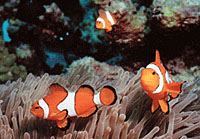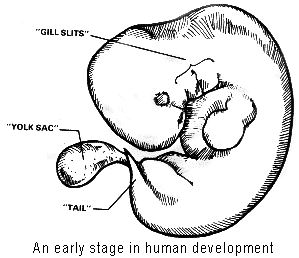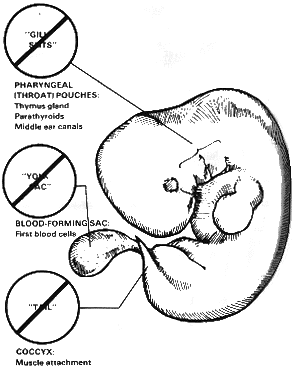Does the human fetus temporarily develop gills, a tail, and a yolk sac?

Did humans evolve from fish and is this “ancestry” reflected by so-called “embryonic recapitulation” and “vestigial” organs?
No, the human fetus never develops gills, tail or a yolk sac, as some have claimed. This supposed evidence of man’s evolution from animals has been resoundingly proven utterly false. This is yet another great evolutionary myth that refuses to die, despite total lack of evidence, and its birth in deception. It was very important in the early promotion of evolutionism.
Unfortunately, many people still believe this erroneous evolutionary theory that was once widely taught in schools and still shows up in museums and books.
How the myth spread | Vestigial organs theory | Tails | Yolk Sacs | Gills | Retracing human “evolutionary development” | The abortion connection | Have any humans ever been born with gills?
Spreading a Popular Myth
In 1986, the Reader’s Digest Book of Facts published an erroneous “fact” that further spread a popular piece of evolutionary misinformation. They told readers that a human embryo re-traces the history of evolution: it develops slits in the neck like fish gills, it has a tail, and so on. This “fact” is so wrong that the idea was discredited and thrown out decades ago.
Earlier, this erroneous “fact” was spread widely by the once-popular child development author Dr. Spock:
“Each child as he develops is retracing the whole history of mankind, physically and spiritually, step by step. A baby starts off in the womb as a single tiny cell, just the way the first living thing appeared in the ocean. Weeks later, as he lies in the amniotic fluid of the womb, he has gills like a fish…”[1]
Where did all this erroneous idea get its start? It began with Evolutionist and German zoologist Ernst Haeckel in his 1876 book General Morphology of Organisms. With supreme audacity it was called the “Biogenetic Law.” It was a fraud from the beginning. Haeckel fraudulently presented altered, misleading and misinterpreted evidence. [2] Some of the key details of his embryo drawings were wrong—purposely altered to make a case for Evolution where none existed. Yet, how many people still know this? Of Haeckel, Richard Milton says, “No errant scientist has been more thoroughly disowned by his colleagues. …The biogenetic law is no longer taken seriously by embryologists.”[3]

Consider the picture above your first “baby picture.” You start off as a little round ball of unformed substance. Then gradually arms, legs, eyes, and all your other parts appear. At one month, you’re not quite as charming as you’re going to be, and here’s where the evolutionist says, “There’s no evidence of creation in the human embryo. Otherwise, why would a human being have a yolk sac like a chicken does and a tail like a lizard does? Why would a human being have gill slits like a fish does? An intelligent creator should have known that human beings don’t need those things.”
THE “YOLK SAC”—evidence of the Creator’s design, not a vestigial organ
Take the so-called “yolk sac,” for instance. In chickens, the yolk contains much of the food that the chick depends on for growth. But we, on the other hand, grow attached to our mothers, and they nourish us. Does that mean the fetus’s so-called “yolk sac” can be cut off from the human embryo because it isn’t needed? Not at all. The “yolk sac” is the source of the human embryo’s first blood cells, and death would result without it.
Now here’s an engineering problem for you. In the adult, you want to have the blood cells formed inside the bone marrow. That makes good sense, because the blood cells are very sensitive to radiation damage and bone would offer them some protection. But you need blood in order to form the bone marrow that later on is going to form blood. So, where do you get the blood first? Why not use a structure similar to the yolk sac in chickens? The DNA and protein for making it are “common stock” building materials. And, since it lies conveniently outside the embryo, it can easily be discarded after it has served its temporary-but vital-function.
Notice, this is exactly what we would expect as evidence of good creative design and engineering practice. Suppose you were in the bridge-building business, and you were interviewing a couple of engineers to determine whom you wanted to hire. One fellow says, “Each bridge I build will be entirely different from all others.” Proudly he tells you “Each bridge will be made using different materials and different processes so that no one will ever be able to see any similarity between the bridges I build.” How does that sound?
Now the next fellow comes in and says, “Well, out back is your yard and I saw a supply of I-beams and various sized heavy bolts and cables. We can use those to span either a river or the San Francisco Bay. I can adapt the same parts and processes to meet a wide variety of needs. You’ll be able to see a theme and a variation in my bridge building, and others can see the stamp of authorship in our work.” Which fellow would you hire?
As Dr. A.E. Wilder-Smith pointed out, we normally recognize in human engineers the principles of creative economy and variations on a theme. That’s what we see in human embryonic development. The same kind of structure that can provide food and blood cells to a chicken embryo can be used to supply blood cells (all that’s needed) for a human embryo. Rather than reflecting time and chance, adapting similar structures to a variety of needs seems to reflect creation.
THE TRUTH ABOUT “GILL” SLITS
The same is true of the so-called “gill slits.” In the human embryo at one month, there are wrinkles (flexion folds) in the skin where the “throat pouches” grow out. Once in a while, one of these pouches will break through, and a child will be born with a small hole in the neck. That’s when we find out for sure that these structures are not gill slits. If the opening were really part of a gill, if it really were a “throwback to the fish stage,” then there would be blood vessels all around it, as if it were going to absorb oxygen from water as a gill does. But there is no such structure. We simply don’t have the DNA instructions for forming gills.
Unfortunately, some babies are born with three eyes or one eye. That doesn’t mean, of course, that we evolved from something with one eye or three eyes. It’s simply a mistake in the normal program for human development, and it emphasizes how perfect our design features and operation must be for life to continue.
The throat (or pharyngeal) grooves and pouches, falsely called “gill slit,” are not mistakes in human development. They develop into absolutely essential parts of human anatomy—the lower jaw, tongue, thymus gland, the parathyroid, etc. The middle ear canals come from the second pouches, and the parathyroid and thymus glands come from the third and fourth.
Without a thymus, we would lose half our immune systems. Without the parathyroids, we would be unable to regulate calcium balance and could not even survive. Another pouch, thought to be vestigial by evolutionists until just recently, becomes a gland that assists in calcium balance. Far from being useless evolutionary vestiges, then, these so-called “gill slits” are quite essential for distinctively human development.
As with “yolk sacs,” “gill slit” formation represents an ingenious and adaptable solution to a difficult engineering problem. How can a small, round egg cell be turned into an animal or human being with a digestive tube and various organs inside a body cavity? The answer is to have the little ball (or flat sheet in some organisms) “swallow itself,” forming a tube which then “buds off” other tubes and pouches. The anterior pituitary, lungs, urinary bladder, and parts of the liver and pancreas develop in this way.
In fish, gills develop from such processes, and in human beings, the ear canals, parathyroid, and thymus glands develop. Following DNA instructions in their respective egg cells, fish and human beings each use a similar process to develop their distinctive features.
THE TRUTH ABOUT HUMAN “TAILS”

What about the “tail”? Some of you have heard that man has a “tail bone” (also called a coccyx), and that the only reason we have it is to remind us that our ancestors had tails. You can test this idea yourself, although I don’t recommend it. If you think the coccyx is useless, fall down the stairs and land on it. (Some of you may have actually done that-unintentionally, I’m sure!) What happens? You can’t stand up; you can’t sit down; you can’t lie down; you can’t roll over. You can hardly move without pain. In one sense, the coccyx is one of the most important bones in the whole body. It’s an important point of muscle attachment required for our distinctive upright posture (and also for defecation, but I’ll say no more about that.)
So again, far from being a useless evolutionary leftover, the coccyx is quite important in human development. True, the end of the spine sticks out noticeably in a one-month embryo, but that’s because muscles and limbs don’t develop until stimulated by the spine (see above picture). As the legs develop, they surround and envelop the coccyx, and it winds up inside the body.
Once in a great while a child will be born with a “tail.” But, is it really a tail? No, it’s not even the coccyx. It doesn’t have any bones in it; it doesn’t have any nerve cord either. The nervous system starts stretched out open on the back. During development, it rises up in ridges and rolls shut. It starts to “zipper” shut in the middle first, then it zippers toward either end. Once in a while it doesn’t go far enough, and that produces a serious defect called spina bifida. Sometimes it rolls a little too far. Then the baby will be born—not with a tail, but with a fatty tumor. It’s just skin and a little fatty tissue, so the doctor can just cut it off. It’s not at all like the tail of a cat that has muscle, bones, and nerve, so cutting it off is not complicated. (So far as I know, no one claims that proves we evolved from an animal with a fatty tumor at the end of its spine.)
The details of human development are truly amazing. We really ought to stop, take a good look at each other, and congratulate each other that we turned out as well as we did!
Retracing Our “Evolutionary Development”?
Evolutionists used to say that human embryonic development retraced states in our supposed evolutionary history. That idea, the now defunct “biogenetic law,” was summarized in the pithy phrase, “ontogeny recapitulates phylogeny.” (Want to sound educated? Just memorize that phrase!) The phrase means that the development of the embryo is supposed to retrace the evolution of its group. As leading anti-creationist Stephen Gould points out, “the theory of recapitulation… should be defunct today,” but Dr. Down named a syndrome “Mongoloid idiocy” because he thought it represented a “throwback” to the “Mongolian stage” in human evolution.[4] It was even once believed that the fertilized egg, for example, would represent our one-celled ancestors, sort of the “amoeba stage.”
Sure enough, we start as small, round structures looking somewhat like single cells. But notice how superficial that argument is. The evolutionists were just looking at the outside appearance of the egg cell. If we look just on the outside appearance, then maybe we’re related to a marble or a ball bearing—they’re small, round things! An evolutionist (or anyone else) would respond, of course, “That’s crazy. Those things are totally different on the inside from a human egg cell.”
But that’s exactly the point. If you take a look on the inside, the “dot” we each start form is totally different from the first cell of every other kind of life. A mouse, an elephant, and a human being are identical in size and shape at the moment of conception. Yet in terms of DNA and protein, right at conception each of these types of life is as totally different chemically as each will ever be structurally. Even by mistake, a human being can’t produce a yolk or gills or a tail, because we just don’t have, and never had, those DNA instructions.
The human egg cell, furthermore, is not just human, but also a special individual. Eye color, general body size, and perhaps even temperament are already present in DNA, ready to come to visible expression. Embryonic development is not even analogous to evolution, which is meant to indicate a progressive increase in potential. The right Greek word instead would be entelechy, which means an unfolding of potential present right from the beginning. That’s the kind of development that so clearly requires creative design.
In reviewing the decline and fall of orthodox Darwinism, John Davy points out that even evolutionists see the need for “theories of another kind” (emphasis his) to explain both the origin and development of distinctive “building plans” among organisms. “Instead of seeing animals as collections of devices for survival, we may have to look at them as more like works of art.”[5] Works of art—that’s the way Creationists have viewed living beings all along!
The Abortion Connection
Amazingly, one can still occasionally find Haeckel’s theory of “embryonic recapitulation” being taught or implied in schools and universities. Some “pro-choice” advocates and abortion clinics have even used this evolutionary concept to make abortion more palatable: “We’re not cutting up a baby; it’s just a fish or a jellyfish. It’s not human; it’s just tissue.”
Once again, deceptive evolutionary claims result in tragic results. In reality, the wonderful process of embryonic development is another marvelous reflection of the Creator’s design.
Footnotes and References

- Adapted from “Evolution of Thought: Reader’s Digest ‘Facts’,” Creation: Ex Nihilo (Acacia Ridge, Queensland, Australia: June 1986)—used by permission. / Dr. Spock’s quotation from Dr. Spock’s Baby and Child Care, (Cardinal Giant Addition, 1957, p. 223), as quoted by Walter J. Bock, “Evolution by Orderly Law”, Science, Vol. 164 (May 9, 1969), pp. 684-685.
“Known as ‘Darwin’s Bulldog on the Continent’ and ‘the Huxley of Germany,’ Ernst Heinrick Philipp August Haeckel is notorious as the scientist who perpetrated fraud upon fraud to promote the theory of evolution. Born at Potsdam, Prussia (now Germany), on February 16, 1834, Haeckel studied medicine and science at Wurtzburg and the University of Berlin, and was professor of zoology at Jena from 1865 until his retirement in 1909. The turning point in his thinking was his reading of Charles Darwin’s Origin of Species, which had been translated into German in 1860. In a letter to his mistress, written when he was 64 and had acquired the nickname of ‘Der Ketzer von Jena’ (the gadfly of Jena), he explained how he began as a ‘Christian’ but after studying evolution became a free-thinker and pantheist. Darwin believed that Haeckel’s enthusiastic propagation of the doctrine of organic evolution was the chief factor in the success of the doctrine in Germany. …he used enormous backdrops showing embryos, skeletons, etc., which has led to his presentation being described as a sort of ‘Darwinian passion play!’ Haeckel’s enthusiasm for the theory of evolution led him to fraudulently manufacture ‘evidence’ to bolster his views. He was the first person to draw an evolutionary ‘family tree’ for mankind.” His frauds included descriptions and detailed pictures protoplasmic organisms called Monera that never existed, a non-existent “speechless apeman,” and illustrations and descriptions of a non-existent “fish stage” in human embryos. The human “fish stage” fraud was first uncovered by comparative embryologist Wilhelm His, Sr. Ernst Haeckel later partially confessed. [Russell Grigg, “Ernst Haeckel: Evangelist for Evolution and Apostle of Deceipt,” Creation: Ex Nihilo, Vol. 18, No. 2 (March-May 1996), pp. 33-36—used by permission of Answers in Genesis.]
Richard Milton, Shattering the Myths of Darwinism (Rochester, Vermont: Park Street Press, 1997), p. 188.
Stephen Jay Gould, “Dr. Down’s Syndrome,” Natural History, Vol. 89 (April 1980), p. 144.
John Davy, “Once Upon A Time,” Observer-Review (London: August 16, 1981).
Editor: Paul S. Taylor, Christian Answers.
Authors:
- Gary Parker in Dr. Henry M. Morris and Dr. Gary E. Parker, What is Creation Science, revised and expanded edition (Green Forest, Arkansas: Master Books, 1982), pp. 61-68—used by permission.
- Ken Ham and Paul S. Taylor, The Genesis Solution (Grand Rapids, Michigan: Baker Book House, 1988), pp. 91-93. Paul S. Taylor, Films for Christ.
Copyright © 1998, Films for Christ, All Rights Reserved—except as noted on attached “Usage and Copyright” page that grants ChristianAnswers.Net users generous rights for putting this page to work in their homes, personal witnessing, churches and schools.